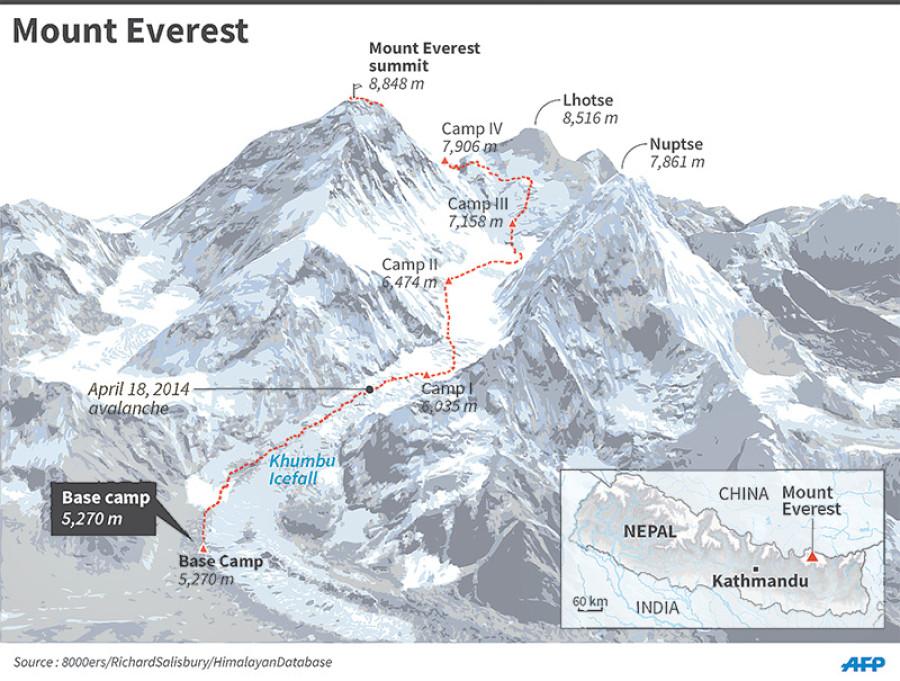Miscellaneous
Extreme mission planned to recover body from Everest
High-altitude climbing guides who have been doing the most dangerous job on the planet are set to embark on the “most challenging, expensive and longest” mission on Everest to retrieve the body of an Indian climber spotted in a 200-metre-deep crevasse near the summit.
Sangam Prasain
High-altitude climbing guides who have been doing the most dangerous job on the planet are set to embark on the “most challenging, expensive and longest” mission on Everest to retrieve the body of an Indian climber spotted in a 200-metre-deep crevasse near the summit.
If this mission is executed, it will be the most complex rescue operation conducted on Everest by far. The mission is being carried out under immense pressure from the Indian government. This may put the lives of many rescuers at risk. Indian climber Ravi Kumar, 27, went missing from the so-called “balcony” (8,400 metres) on Everest on Saturday. His body was spotted on Monday morning after 36 hours of intense search.
“The bereaved family wants the body at any cost,” said Chowang Sherpa, managing director of Arun Treks and Expedition, the agency handling Kumar’s expedition. “We weren’t ready for these challenges,” he said. “The precariously balanced ice can tumble down at any time,” said Sherpa. “It’s extremely difficult and dangerous.”
Given the risks involved in spending so much time at high altitudes, many climbing teams decide not to bring down dead bodies.
On Monday, a discussion lasting more than two hours was held at the Indian Embassy whether to retrieve the body or not. “We clearly told Indian government officials that the mission involved high risks and would be costly,” said Sherpa. “As it is a matter of family grief, we decided to take the risk, but the Indian government should guarantee the funds needed for the operation,” he said.
A decision to undertake the mission is expected to be made by Tuesday if funds are arranged. “Accordingly, we will arrange the logistics and required manpower.” The mission is expected to cost $60,000-$70,000. At least 10 high-altitude climbing guides will be needed. And it will take at least four days to complete the mission if the weather is good. Each rescuer should be paid a fee of $1,000 daily.
Such rescue operations require a large number of oxygen cylinders, at least 40 cylinders. Each cylinder costs $500. Besides, helicopters need to be flown up to Camp III (7,200 metres) to bring down the body.
“Going down into a crevasse 200 metres deep at an altitude of 8,400 metres to retrieve the body will be the most complex rescue ever executed on Everest,” said Ang Tshering Sherpa, president of the Nepal Mountaineering Association (NMA). “That’s why there is a 50/50 chance of survival for the rescuers.”
Three to four missions have already been dispatched to retrieve bodies lying above 8,000 metres, but they collected bodies found along the way, said the NMA president. “If the body is frozen, it has to be dug out with the ice covering it, and that increases the costs. There is also the possibility of an avalanche.”
Kumar had reached the summit with his guide at 1:28pm on Saturday. The Indian climber collapsed during the descent at 8pm due to low level of energy and oxygen.
He had forced his guide to push for the summit even though it was not a good time, according to the expedition organiser.
The guide left Kumar on the balcony with auxiliary oxygen as he couldn’t walk.
The guide descended to Camp IV to send a rescue team as he was suffering from frostbite and snow blindness. Three high-altitude guides reached the spot, but they couldn’t find the Indian climber.
Climbers from the US and Slovakia also died on the Nepal side of the mountain on Sunday.




 15.12°C Kathmandu
15.12°C Kathmandu










